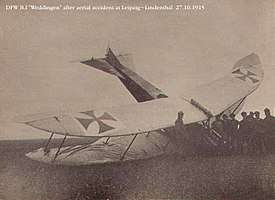DFW B.I
| B.I and B.II | |
|---|---|
 | |
| DFW B.I Tannenberg, one of the few "named" DFW aircraft | |
| Role | Reconnaissance / Army co-operation |
| Manufacturer | Deutsche Flugzeugwerke |
| Designer | Walter Oelerich |
| Introduction | 1914 |
| Retired | 1915 |
| Primary user | Luftstreitkräfte |

Crashed DFW B.I "Weddingen" showing shape of wings
The DFW B.I (factory designation MD 14), was one of the earliest German aircraft to see service during World War I, and one of the numerous "B-class" unarmed, two-seat observation biplanes of the German military in 1914, but with a distinctive appearance that differentiated it from contemporaries.[1] Though a biplane, its crescent-shaped three-bay wings were inspired by that of the earlier Rumpler Taube monoplane, and led to the DFW aircraft being named the Fliegende Banane ("Flying Banana") by its pilots.
The B.II was similar but was built as a trainer. Some were fitted with the more powerful Mercedes D.II engine.
Specifications (DFW B.I)
Data from German Aircraft of the first World War[2]
General characteristics
- Crew: 2
- Length: 8.4 m (27 ft 7 in)
- Wingspan: 14 m (45 ft 11 in)
- Height: 3 m (9 ft 10 in)
- Wing area: 40 m2 (430 sq ft)
- Empty weight: 650 kg (1,433 lb)
- Gross weight: 1,015 kg (2,238 lb)
- Powerplant: 1 × Mercedes D.I 6-cyl. water-cooled in-line piston engine, 75 kW (100 hp)
Performance
- Maximum speed: 120 km/h (75 mph; 65 kn)
- Range: 600 km (373 mi; 324 nmi)
- Service ceiling: 3,000 m (9,800 ft)
See also
- Related lists
References
External links
| Wikimedia Commons has media related to DFW B.I. |
This article is issued from
Wikipedia.
The text is licensed under Creative Commons - Attribution - Sharealike.
Additional terms may apply for the media files.